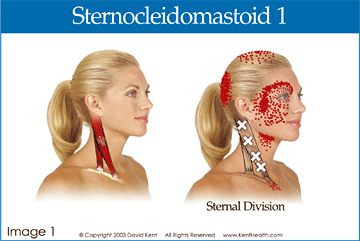Are You Suffering From Trigger Point Pain?

When it comes to treating joint and muscle pain, not all therapies work for all people and for all conditions and at all times.
You ARE a special snowflake!
Want to save time, money and the pain of unhelpful treatments? Getting an accurate diagnosis as to what’s causing your pain will take you a long way :) So let’s specifically chat about trigger points.
What makes this muscle pain different from all other muscle pains?
A trigger point is an area of hypertonic or tense muscle tissue. Usually the cause of these areas of tension is due to overuse or hyperactive musculature. Think improper posture, trauma, or repetitive use.
Here’s the zinger (literally): trigger points are known to refer pain along a specific pattern to certain areas of the body. Sometimes these patterns may be far, far away from the trigger point’s origin.

For example: trigger points in this particular neck muscle cause head, facial, and throat pain. Surprising!
Could you be suffering from trigger point pain?
How would you know?
Here are some common scenarios I’ve seen in practice:
- Playing a game of ‘what’s causing your pain’ and a massage therapist presses on a tight spot in your muscle and it zings pain or electricity to another location (think: pressing on a muscle nodule in your upper trapezius…and bam! Headaches re-created.)
- Visiting a doctor who diagnoses you with trigger points, then offers you injections (aka ‘make the pain shut up’ method. Quick fix, no sustainable results.)
- Suffering from headaches, joint or muscle pain and you’ve ALREADY had treated without success.
- Working with a doctor/therapist who is trained in detecting, locating, and relieving these pesky bastards to give you sustained relief and a method of preventing them in the future.
I’m a fan of Option #4 for both short AND long term relief.
Trigger points are sometimes referred to as “knots” and can feel like a tense nodule within an otherwise soft muscle. The result of trigger points can also be pain, tenderness, stiffness, and/or decreased range of motion. Releasing a trigger point can be accomplished via a few different therapeutic options: 1) steady compression of the point 2) using a cold application and stretching, 3) by a deeper, Eastern technique known as cupping, 4) acupuncture.
Utilizing relaxation and/or yoga with trigger point therapy has been associated with the most successful results and the shortest time frame. Some patients have seen a reduction of pain and an improvement in symptoms within their first visit but consistent treatment and care has been shown to be associated with the most successful results.
Would you believe THIS is a list of possible symptoms due to trigger points?
